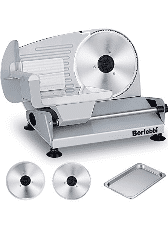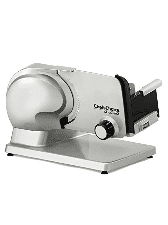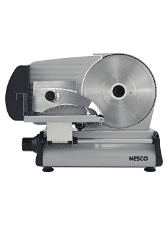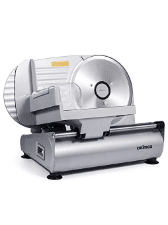Join the millions that have trusted Haffprice to help them make smarter buying decisions. Let our independent expert reviews and data-driven shopping recommendations help you find the baby monitor that’s right for you.
#1

10.0
Anescra Meat Slicer
- Cust meat, bread, fruit, & more
- Adjustable thickness control dial
- 7.5″ serrated & non-serrated steel blades
- Non-slip feet
- Removeable parts for easy clean
Picked by 452 people this month!

#2

9.9
BESWOOD Premium Meat Slicer
- Cuts meat, veggies, & more
- 12 thickness options
- 10″ carbon steel blade
- Blade ring guard for safety
- Cleaning brush included

#3

9.5
Borlebbi Meat Slicer
- Cut meat, cheese, vegetables, bread, & more
- Adjustable thickness dial (0mm – 15mm)
- 7.5″ stainless steel serrated blade & non-serrated blade
- Non-slip feet & food pusher safety features
- Removable parts for easy cleaning

#4

9.1
KWS Commercial Electric Meat Slicer
- Cuts deli meat, cheese, frozen meat, and more
- Adjustable thickness dial
- 10″ stainless steel teflon blade
- Non-slip feet
- Removeable parts for easy cleaning

#5

9.0
Vevor Commercial Meat Slicer
- Cut meat, cooked food, cheese, roast beef, & more
- Adjustable thickness dial (0mm – 12mm)
- 10″ chromium-plated steel blade
- Built-in blade sharpener, fixed shield, non-slip feet, & food pusher safety features
- Removable parts for easy cleaning

#6

9.0
Chef’s Choice Electric Meat Slicer
- Cuts meat, cheese, fruit, & more
- 20 thickness options
- 7″ serrated cast aluminum blade
- Safety lock position
- Removeable parts for easy cleaning

#7

8.8
NESCO Meat Slicer
- Cuts meat, cheese, bread, & more
- Adjustable thickness knob
- 8.7″ serrated hardened steel blade
- Non-slip feet
- Removeable parts for easy cleaning

#8
8.7
Techwood Meat Slicer
- Cuts meat, cheese, & more
- Adjustable thickness dial
- 9″ stainless steel blade
- Non-slip feat
- Dishwasher safe parts

#9

8.5
KWS Commercial Meat Slicer
- Cuts meat, cheese, & more
- Adjustable thickness dial
- 10″ stainless steel blade
- Non-slip feet
- Removeable parts for cleaning

#10

8.4
Cusimax Electric Meat Slicer
- Cuts meat, cheese, fruit, & more
- Adjustable thickness dial
- 7.5″ non-serrated stainless steel blade
- Non-slip feet
- Removeable parts for cleaning

We also considered 2 other:
Our Top Choice
#1

10.0
Anescra Meat Slicer
- Cust meat, bread, fruit, & more
- Adjustable thickness control dial
- 7.5″ serrated & non-serrated steel blades
- Non-slip feet
- Removeable parts for easy clean
Picked by 452 people this month!

About Our Rankings:
Our recommendations are based on expert comparisons between available products in each product category. For baby monitor, we chose the topics that we think matter most to our users, and provide consise, clear comparisons of the features that matter. Our rankings change day-to-day based on our proprietary algorithms, that crunch data to identify top-performing products and tailor recommendations to exactly what our readers are looking for.

20
Models
Evaluated

3
Topics
Considered

11
Hours of
Research

3,126
Purchases
Analyzed
Meat Slicer Buyer's Guide
 A meat slicer gives you an easy way to have deli-style meats at home. Choosing one should come down to durability, versatility, and safety.
A meat slicer gives you an easy way to have deli-style meats at home. Choosing one should come down to durability, versatility, and safety.
Overview
When shopping for a meat slicer, it’s important to know what to look for so you can easily compare products. Here are some considerations to keep in mind:
What are the important features of a meat slicer?
There are several key features to meat slicers. Meat slicers are made of a blade, a food carriage, a food pusher, a food deflector, and a knob or dial to adjust the width of the slice.
Meat slicer blades typically vary from 7 inches to 14 inches. Smaller blades are ideal for light cutting while larger blades are more powerful. Blades can also be serrated or non-serrated. Non-serrated blades tend to be more versatile and easier to sharpen. You will want to check to see what blade is included with your meat slicer and if you can purchase additional blades at a later date.
The food carriage, food pusher, and food deflector all help hold your meat in place while it is slowly pushed under the blade. These features work together to make sure the meat slides easily but is also secure.
What makes the best meat slicer?
The best meat slicer will vary quite a bit depending on what you intend to use your meat slicer for and how often you plan on using it. Regardless of your intended use, the best meat slicers will be powerful, durable, and have good safety features.
Most meat slicers have blades made of carbon steel or stainless steel. Stainless steel blades tend to have a longer life with less rust, but carbon steel blades are often slightly sharper.
You will also want to look at the available power output for each meat slicer you are researching. Basic meat slicers have motors starting around 120 watts, and commercial quality slicers range up to 320 watts. You will be able to slice thicker and tougher cuts of meat with higher power machines.
Safety is an important element of choosing the best meat slicer. Many options on the market today have a variety of safety features including locks to prevent the blade from slicing and ring guards that prevent you from accidentally touching the blade. When looking at how the body of the meat slicer is made, look at what type of grips or feet are included. Rubber feet or grips will help the machine stay in place while slicing while plastic feet may slide on the kitchen countertop. Machines that slide while in use could present a safety concern.
What are the different types of meat slicers?
 There are two main types of meat slicers: home meat slicers and commercial-grade meat slicers. A meat slicer meant for home use will typically have a lower power output and is designed for shorter or more infrequent use. Meat slicers are also either manual, semi-automatic, or automatic. Meat slicers you will purchase for your home will be either manual or semi-automatic.
There are two main types of meat slicers: home meat slicers and commercial-grade meat slicers. A meat slicer meant for home use will typically have a lower power output and is designed for shorter or more infrequent use. Meat slicers are also either manual, semi-automatic, or automatic. Meat slicers you will purchase for your home will be either manual or semi-automatic.
=”” p=””>
Is a meat slicer worth it?
Pre-sliced meat, such as from the deli counter in a supermarket, is more expensive than meat that is sliced at home. A meat slicer is a great addition to the home of someone who often prepares large cuts of meat, like the kind you would cook on a meat smoker or get from hunting.
Meat slicers can also be used for other purposes, such as slicing cheeses, vegetables, or even breads. Having a meat slicer will be a time-saving tool for people who host parties and events in their home. While a meat slicer does have an initial investment cost, it will pay off in the long run if you use it frequently and no longer buy pre-sliced meats and cheeses from the store.
Meat Slicer FAQ
So how do you choose the meat slicer that’s right for you? These are the questions consumers are asking when shopping for meat slicers.
Can meat slicers cut raw meat and frozen meat?
Both home and commercial meat slicers can cut through raw meat. Cutting raw meat, however, poses problems of contamination. Anytime you cut raw meat, you will need to properly clean and sanitize your slicer. While some meat slicers may cut through frozen meat, many will not do so cleanly or smoothly. It is best to defrost your meat before trying to slice.
What thickness can I cut with a meat slicer?
Meat slicers will vary in the exact width of their sliced meat, but most can slice from shaved up to ½ or ¾ inch thick. Higher quality or commercial-grade meat slicers will usually allow you greater variability in your slice thickness.
 How do you sharpen a meat slicer blade?
How do you sharpen a meat slicer blade?
Some meat slicers will come with a sharpening tool, such as a whetstone. If the meat slicer you purchase does not come with a sharpener, you will want to purchase one separately. Meat slicer blades should be sharpened every few weeks if you use your machine regularly.
How do you clean a meat slicer?
Each meat slicer will come with specific instructions on how to clean the various parts. At minimum, the blade, food carriage, and food pusher should be wiped down and sanitized with food-grade cleaners after each use. Some meat slicers have removable parts that can be placed in the dishwasher.
Final Thoughts
There are many options to consider when you are shopping for a meat slicer to add to your kitchen. With many blade sizes, thickness options, and power output choices available, you can find the perfect meat slicer to use in your home.

Written By Ryan W.
Ryan graduated with a degree in journalism and spent years building his writing career in the tech media field. An avid fan of gadgets and tech in general, Ryan has spent years testing and reviewing a wide array of devices. He specializes in reviewing everything from laptops and smartphones to more niche items like smart home devices and security cameras.
This site is a free online resource that strives to offer helpful content and comparison features to its visitors. Please be advised that the operator of this site accepts advertising compensation from companies that appear on the site, and such compensation impacts the location and order in which the companies (and/or their products) are presented, and in some cases may also impact the rating that is assigned to them. To the extent that ratings appear on this site, such rating is determined by our subjective opinion and based on a methodology that aggregates our analysis of brand market share and reputation, each brand’s conversion rates, compensation paid to us and general consumer interest. Company listings on this page DO NOT imply endorsement. Except as expressly set forth in our Terms of Use, all representations and warranties regarding the information presented on this page are disclaimed. The information, including pricing, which appears on this site is subject to change at any time.


